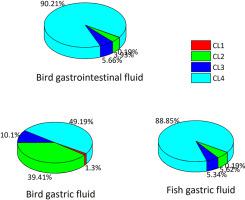当前位置:
X-MOL 学术
›
Environ. Pollut.
›
论文详情
Our official English website, www.x-mol.net, welcomes your feedback! (Note: you will need to create a separate account there.)
Revealing chemical release from plastic debris in animals’ digestive systems using nontarget and suspect screening and simulating digestive fluids
Environmental Pollution ( IF 8.9 ) Pub Date : 2024-03-19 , DOI: 10.1016/j.envpol.2024.123793 Xianzhi Peng , Tao Yang , Shang Guo , Jing Zhou , Guangshi Chen , Zewen Zhu , Jianhua Tan
Environmental Pollution ( IF 8.9 ) Pub Date : 2024-03-19 , DOI: 10.1016/j.envpol.2024.123793 Xianzhi Peng , Tao Yang , Shang Guo , Jing Zhou , Guangshi Chen , Zewen Zhu , Jianhua Tan

|
Plastic debris in the environment are not only pollutants but may also be important sources of a variety of contaminants. This work simulated kinetics and potential of chemical leaching from plastic debris in animals' digestive systems by incubating polyvinyl chloride (PVC) cord particles in artificial digestive fluids combined with nontarget and suspect screening based on UHPLC-Orbitrap HRMS. Impacts of particle size, aging, and digestive fluid were investigated to elucidate mechanisms of chemical leaching. Thousands of chemical features were screened in the leachates of PVC cord particles in the artificial digestive fluids, among which >60% were unknown. Bisphenol A (BPA) and bis(2-ethylhexyl) phthalate (DEHP) were the dominant identified CL1 compounds. Finer size and aging of the PVC particles and prolonged incubation time enhanced chemical release, resulting in greater numbers, higher levels, and more complexity in components of the released chemicals. The gastrointestinal fluid was more favorable for chemical leaching than the gastric fluid, with greater numbers and higher levels. Hundreds to thousands of chemical features were screened and filtered in the leachates of consumer plastic products, including food contact products (FCPs) in the artificial bird gastrointestinal fluid. In addition to BPA and DEHP, several novel bisphenol analogues were identified in the leachate of at least one FCP. The results revealed that once plastic debris are ingested by animals, hundreds to thousands of chemicals may be released into animals’ digestive tracts in hours, posing potential synergistic risks of plastic debris and chemicals to plastic-ingesting animals. Future research should pay more attentions to identification, ecotoxicities, and environmental fate of vast amounts of unknown chemicals potentially released from plastics in order to gain full pictures of plastic pollution in the environment.
中文翻译:

使用非目标和可疑筛选和模拟消化液揭示动物消化系统中塑料碎片的化学释放
环境中的塑料碎片不仅是污染物,还可能是多种污染物的重要来源。这项工作通过在人工消化液中孵育聚氯乙烯 (PVC) 绳索颗粒,并结合基于 UHPLC-Orbitrap HRMS 的非目标和可疑筛选,模拟了动物消化系统中塑料碎片化学浸出的动力学和潜力。研究了粒径、老化和消化液的影响,以阐明化学浸出的机制。在人工消化液中PVC绳索颗粒的浸出液中筛选出数千种化学特征,其中>60%是未知的。双酚 A (BPA) 和邻苯二甲酸双(2-乙基己基)酯 (DEHP) 是主要的已鉴定 CL1 化合物。 PVC 颗粒的更细尺寸和老化以及更长的孵育时间增强了化学物质的释放,导致释放的化学物质成分的数量更大、含量更高、更复杂。胃肠液比胃液更有利于化学浸出,数量更多、含量更高。在消费塑料产品的渗滤液中筛选和过滤了数百至数千种化学特征,其中包括人造鸟类胃肠液中的食品接触产品(FCP)。除了 BPA 和 DEHP 之外,在至少一种 FCP 的渗滤液中还发现了几种新型双酚类似物。结果显示,塑料碎片一旦被动物摄入,数百至数千种化学物质可能在数小时内释放到动物的消化道中,对摄入塑料的动物构成塑料碎片和化学物质的潜在协同风险。未来的研究应更多地关注塑料中可能释放的大量未知化学物质的识别、生态毒性和环境归趋,以便全面了解环境中的塑料污染。
更新日期:2024-03-19
中文翻译:

使用非目标和可疑筛选和模拟消化液揭示动物消化系统中塑料碎片的化学释放
环境中的塑料碎片不仅是污染物,还可能是多种污染物的重要来源。这项工作通过在人工消化液中孵育聚氯乙烯 (PVC) 绳索颗粒,并结合基于 UHPLC-Orbitrap HRMS 的非目标和可疑筛选,模拟了动物消化系统中塑料碎片化学浸出的动力学和潜力。研究了粒径、老化和消化液的影响,以阐明化学浸出的机制。在人工消化液中PVC绳索颗粒的浸出液中筛选出数千种化学特征,其中>60%是未知的。双酚 A (BPA) 和邻苯二甲酸双(2-乙基己基)酯 (DEHP) 是主要的已鉴定 CL1 化合物。 PVC 颗粒的更细尺寸和老化以及更长的孵育时间增强了化学物质的释放,导致释放的化学物质成分的数量更大、含量更高、更复杂。胃肠液比胃液更有利于化学浸出,数量更多、含量更高。在消费塑料产品的渗滤液中筛选和过滤了数百至数千种化学特征,其中包括人造鸟类胃肠液中的食品接触产品(FCP)。除了 BPA 和 DEHP 之外,在至少一种 FCP 的渗滤液中还发现了几种新型双酚类似物。结果显示,塑料碎片一旦被动物摄入,数百至数千种化学物质可能在数小时内释放到动物的消化道中,对摄入塑料的动物构成塑料碎片和化学物质的潜在协同风险。未来的研究应更多地关注塑料中可能释放的大量未知化学物质的识别、生态毒性和环境归趋,以便全面了解环境中的塑料污染。



























 京公网安备 11010802027423号
京公网安备 11010802027423号